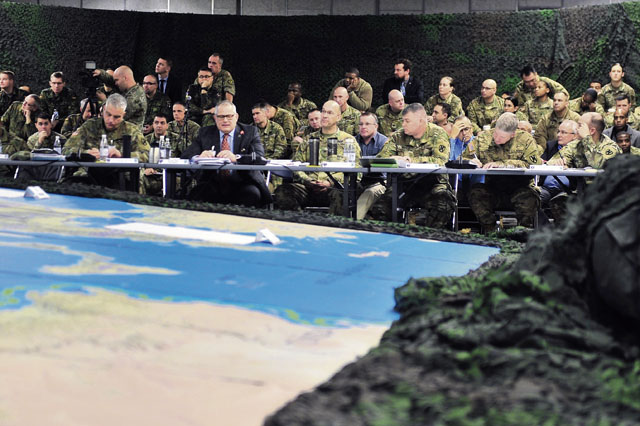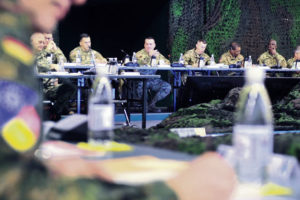
To prepare for the simultaneous movement of four combat brigades across Europe in the new year, leaders from 21st Theater Sustainment Command closed out 2018 with a rehearsal of concept drill Dec. 14 at Rhine Ordnance Barracks.

Allies and partners to include commercial carriers, representatives from the Belgian, German and Polish militaries, U.S. Army Europe, U.S. European Command, Supreme Headquarters Allied Command Europe and NATO, and the various units which will be involved in the movements, attended the full-day meeting to gain a common understanding of the movement plan.
“This is where everybody understands their role for moving their units into and out of the theater,” said Maj. Gen. Steven Shapiro, commanding general, 21st TSC. “This facilitates freedom of movement because you know the plan. We have our German host nation folks here, we have our Belgian host nation folks here, so they understand the support we require of them so we can coordinate that well in advance.
The key is having our Belgian allies, our German allies and our Polish allies all understanding the plan and agreeing to the plan so when you come to these border friction points you can keep on moving through,” he added. “That is freedom of movement.”
Maj. Oliver Davis, branch chief, future operations, 21st TSC and the officer in charge of the ROC drill, said the meeting allows the various elements to rehearse their movements from the ports all the way to the end destination.
“(It) really takes a whole lot of teamwork between the sustainment enterprise, multiple commercial agencies and also the units that we are supporting,” Davis said.
During the drill leaders discussed the lessons learned from previous rotations, how to gather and apply movement data with commercial carriers, how to improve the logistics process and ways to increase the speed and freedom of movement of military units in Europe.
“We still have some more learning to do but we are much better,” Shapiro said. “It is the learning process of this entire freedom of movement enterprise that I think is going to make us a much better organization.”
Attendees also discussed the plan for the concurrent rotation in coming months and how the sustainment command’s operations would synchronize with higher commands if more forces were needed in Europe to combat foreign aggression.
“It’s not just the host nations, but the SHAPE, NATO and EUCOM presence here is very important, so they can understand how the U.S. ground movement is going to happen,” Shapiro said. “Not just for these four brigades, but if we had to do it on a much larger scale.”
While the movement was the focus of the drill, leadership also talked about the importance of meeting the needs for the Soldiers rotating in and out.
“At the end of the day it’s really just about making sure the Soldiers who are being supported that are here for 9-month rotations get the world-class support they deserve,” Davis said.
1st Armored Brigade Combat Team, 1st Infantry Division will replace 1st Armored Brigade Combat Team, 1st Cavalry Division, and 1st Combat Aviation Brigade, 1st Infantry Division will replace 4th Combat Aviation Brigade, 4th Infantry Division in late January through early February.


